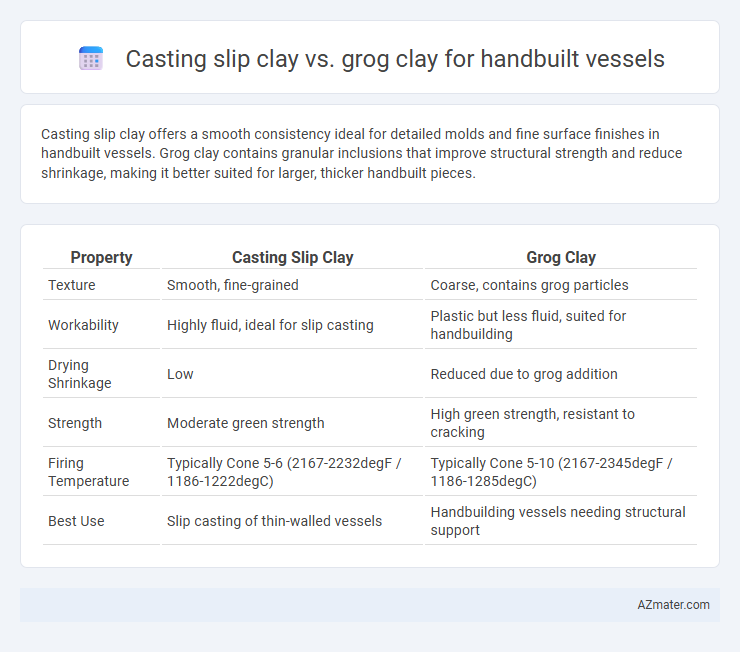Casting slip clay offers a smooth consistency ideal for detailed molds and fine surface finishes in handbuilt vessels. Grog clay contains granular inclusions that improve structural strength and reduce shrinkage, making it better suited for larger, thicker handbuilt pieces.
Table of Comparison
| Property | Casting Slip Clay | Grog Clay |
|---|---|---|
| Texture | Smooth, fine-grained | Coarse, contains grog particles |
| Workability | Highly fluid, ideal for slip casting | Plastic but less fluid, suited for handbuilding |
| Drying Shrinkage | Low | Reduced due to grog addition |
| Strength | Moderate green strength | High green strength, resistant to cracking |
| Firing Temperature | Typically Cone 5-6 (2167-2232degF / 1186-1222degC) | Typically Cone 5-10 (2167-2345degF / 1186-1285degC) |
| Best Use | Slip casting of thin-walled vessels | Handbuilding vessels needing structural support |
Introduction to Casting Slip Clay and Grog Clay
Casting slip clay is a finely ground, fluid mixture of clay and water ideal for creating detailed molds in handbuilt vessels, offering smooth surfaces and precision shaping. Grog clay incorporates pre-fired, crushed ceramic particles that enhance durability and reduce shrinkage during drying and firing, making it suitable for robust, textured handbuilt forms. Both materials cater to specific functional needs in pottery, with casting slip emphasizing fine detail and grog clay providing structural strength.
Key Differences Between Slip Clay and Grog Clay
Casting slip clay is a liquid clay mixture with fine particles that offers smooth surfaces and intricate detail for handbuilt vessels, while grog clay contains coarse, pre-fired clay particles (grog) that improve strength and reduce shrinkage. Slip clay is ideal for delicate, thin-walled forms due to its plasticity and ease of molding, whereas grog clay provides durability and structural support, making it suitable for larger, functional pottery. The key differences lie in texture, workability, and firing behavior, with slip clay favoring finesse and grog clay enhancing mechanical stability.
Physical Properties: Texture and Workability
Casting slip clay offers a smooth texture with fine particle size, making it ideal for detailed, thin-walled handbuilt vessels but tends to be less structurally supportive during forming. Grog clay contains coarse, pre-fired grog particles that enhance strength and reduce shrinkage, providing a rougher texture that improves grip and workability for thicker, robust handbuilt forms. The choice impacts drying time and mechanical stability, with casting slip clay favoring delicate shaping and grog clay excelling in durability and resistance to cracking during drying and firing.
Suitability for Handbuilt Vessels
Casting slip clay offers a smooth, fine texture ideal for delicate handbuilt vessels requiring precise detailing, but it can be prone to warping and cracking due to its high shrinkage rate. Grog clay contains ground fired clay particles that improve structural strength and reduce shrinkage, making it more suitable for larger, thicker handbuilt vessels that require durability and better resistance during drying and firing. For handbuilding techniques, grog clay provides enhanced workability and prevents deformation, whereas casting slip clay is preferred when achieving fine surface finishes is essential.
Strength, Durability, and Shrinkage Rates
Casting slip clay offers fine particle consistency resulting in smooth surfaces but tends to have higher shrinkage rates and lower strength compared to grog clay. Grog clay incorporates pre-fired clay granules that enhance structural strength and durability by reducing cracking and warping during drying and firing. Shrinkage rates in grog clay are significantly lower, improving dimensional stability for handbuilt vessels subjected to stress.
Surface Finishes and Glaze Compatibility
Casting slip clay offers a smooth, fine surface ideal for intricate details and glassy glaze finishes, enhancing visual clarity on handbuilt vessels. Grog clay contains coarse particles that create a textured, rough surface, which resists cracking and adds a rustic aesthetic but can affect glaze adhesion and result in uneven finishes. For glaze compatibility, casting slip clay works well with thin, even glazes while grog clay suits matte or speckled glazes that embrace its natural texture.
Drying and Firing Considerations
Casting slip clay offers a smooth texture essential for fine detail but requires slow, even drying to prevent cracking due to higher shrinkage rates. Grog clay contains pre-fired, ground materials that improve structural integrity by reducing warping and shrinkage during drying and firing, making it ideal for larger handbuilt vessels. Firing grog clay is generally more forgiving at high temperatures, supporting durability, while casting slip clay demands precise kiln control to avoid defects.
Creative Possibilities and Design Versatility
Casting slip clay offers smooth surfaces and fine detail, ideal for intricate designs and delicate textures in handbuilt vessels. Grog clay contains grog particles that enhance structural strength and texture, allowing for more robust, sculptural forms and varied tactile finishes. Combining slip clay's precision with grog clay's durability expands creative possibilities and design versatility in handmade pottery.
Cost and Accessibility of Materials
Casting slip clay offers a cost-effective option for handbuilt vessels due to its fluid consistency, which reduces material waste and allows efficient mold use, making it accessible for beginners and budget-conscious artists. Grog clay contains pre-fired, granular particles that enhance structural strength but often comes at a higher price point and may require sourcing specialized suppliers, limiting its availability in some regions. Choosing between casting slip and grog clay depends on balancing budget constraints and the desired durability of the final handbuilt vessel.
Choosing the Right Clay for Your Handbuilt Vessel
Selecting the right clay for your handbuilt vessel depends on the desired texture and firing characteristics. Casting slip clay offers a smooth, fine texture ideal for detailed work and thin walls, while grog clay incorporates granular particles that provide added strength and reduce shrinkage during firing. Understanding the balance between plasticity and firmness helps artists achieve durability and the aesthetic finish suited to their project.

Infographic: Casting slip clay vs Grog clay for Handbuilt vessel
 azmater.com
azmater.com